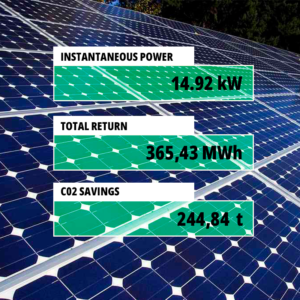A Story of an Oregon Homeowner
Meet Emily, an Oregon homeowner eager to reduce her electric bills and gain energy independence. Like many others, she was excited to switch to solar, but she soon discovered unexpected home solar problems. After a door-to-door solar salesman offered her a tempting deal with low upfront costs and promises of “never paying another electricity bill,” she signed up without comparing options. Before long, Emily encountered several issues: the installation was rushed, low-quality equipment was used, and unnoticed roof damage occurred. Her electric bills didn’t drop as promised, and a year later, the company had disappeared, leaving her with a malfunctioning system and costly repairs.
Emily’s story mirrors the home solar problems that can arise when working with unreliable companies, as highlighted in NPR’s “The Dark Side of Rooftop Solar,” To avoid similar issues, it’s crucial to research and work with reputable solar providers like Advanced Energy Systems. Let’s explore the top seven home solar problems to avoid when choosing a solar installer5.
What PRE-Installation Solar Issues to Watch For? Common Home Solar Problems Before Installation
The pre-installation assessment is one of the most overlooked yet crucial phases of a solar installation. Skipping or rushing through this step can lead to home solar problems that impact system performance and longevity. Poor planning and inadequate site assessments can result in issues such as improper system design, incompatible roof types, and overlooked obstacles like chimneys or skylights—all of which can reduce the efficiency and functionality of your solar system. To avoid these issues, it’s important to compare offers carefully and select a reliable installer. Learn more in our guide: Is It Advisable to Compare Multiple Quotes for Solar Installation?.
Let’s explore how these common pre-installation missteps contribute to home solar problems that can cause long-term headaches for homeowners.

What Happens if My Installer Doesn’t Do a Proper Site Assessment?
A thorough site assessment is crucial for a successful solar installation, yet skipping this step is one of the most common home solar problems. Some installers may skip the on-site visit and rely on satellite imagery or outdated roof layouts, often leading to inaccurate designs. For instance, if your roof includes elements like chimneys, skylights, vents, or HVAC units that aren’t accounted for during the design phase, your solar panels may end up in suboptimal locations, reducing energy production and potentially causing roof damage over time.
What Can Go Wrong?
-
Shading issues: Obstructions such as chimneys, vents, or nearby trees can cast shadows on your solar panels, significantly reducing their efficiency. If these obstacles aren’t identified during the assessment, your panels may produce less energy than expected.
-
Roof obstructions: Failing to account for roof elements like chimneys or skylights can limit panel placement, reduce system capacity, and lead to awkward layouts that hinder performance.
-
Panel underperformance: Poorly planned layouts often result in inefficient energy production, which can extend payback periods and reduce potential savings on energy bills.
Solution: To avoid these home solar problems, ensure your installer conducts an in-person site assessment to accurately consider any roof obstructions. A quality installer will design a system that maximizes sun exposure and positions panels around obstacles, ensuring the most efficient layout for your home.
Is My Roof Compatible with Solar Panels?
Ensuring that your roof is compatible with solar panels is crucial for a successful installation and long-term performance. Different roof types require specific installation methods, and if your roof isn’t properly assessed, it can lead to home solar problems like poor panel performance, roof damage, or costly repairs. Roof compatibility directly impacts both how well your solar panels perform and how long they last.
Common Roof Types and Their Compatibility with Solar:
- Asphalt shingles: The most common roof type, typically easy to work with and compatible with standard solar installation methods.
- Metal roofs: Highly durable and compatible with solar but may require specialized mounting systems to prevent damage and ensure stability.
- Tile roofs: Require skilled, experienced installers, as these roofs can be easily damaged during installation if not handled correctly.
- Flat roofs: Offer flexibility for panel placement but need additional mounting hardware to set the angle and orientation for optimal energy production.
In regions like Oregon, where weather conditions fluctuate throughout the year, selecting the proper installation approach is essential. Poor mounting practices on incompatible roofs can result in home solar problems such as roof leaks or panel instability over time.
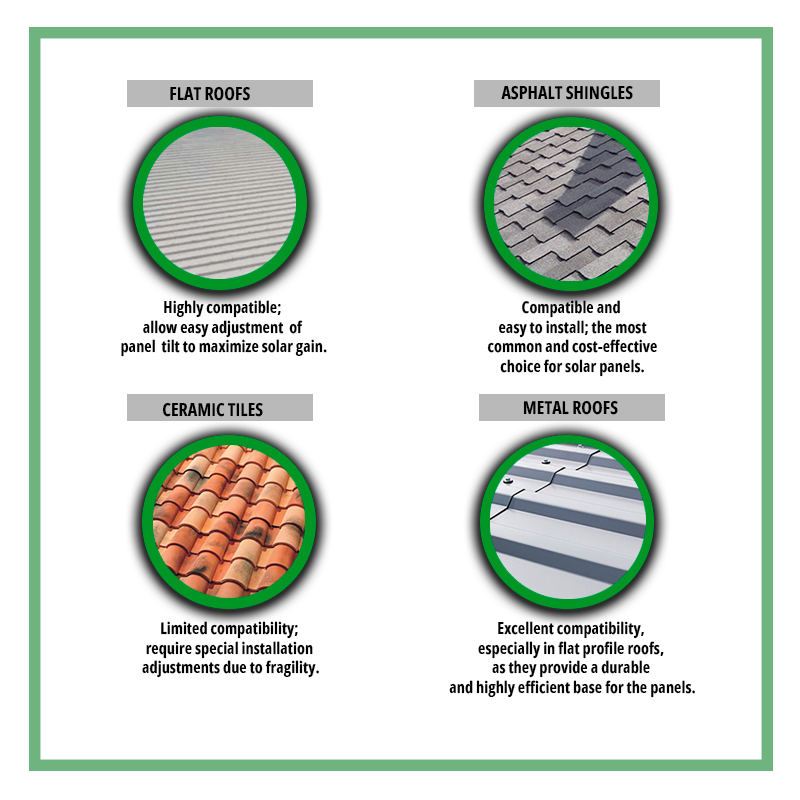
What Can Go Wrong?
- Roof leaks: If flashing is not installed correctly, water can seep into your roof, causing significant damage over time.
- Roof damage: Inexperienced installers can damage tiles or fail to secure mounting points properly, leading to structural problems and potential long-term costs.
Solution: To avoid these home solar problems, work with certified installers who will thoroughly assess your roof’s condition and recommend the appropriate installation method for your specific roof type. This will ensure a secure, weather-resistant installation that maximizes energy production and protects your roof.
Are Permitting and Insurance Requirements Important for Solar Installations?
Yes, and neglecting these requirements can lead to severe problems. Installing a residential solar system involves navigating local permitting and insurance requirements. Local governments typically require permits for solar installations to ensure compliance with building codes, and failure to secure the necessary permits can result in fines or the need to remove and reinstall the system. “Proper permitting and insurance are foundational to ensuring that your solar installation is legally compliant and financially protected against unforeseen events,” explains a solar expert at Advanced Energy Systems.
Additionally, if homeowners fail to update their insurance policies to reflect the addition of solar panels, they may not be covered for damages related to the system. For example, in the event of a fire or severe weather, if the solar panels are not included in the homeowner’s insurance policy, any damage to them may not be covered.

What Can Go Wrong?
- Lack of permits: This can lead to removal or fines.
- No insurance update: Leaves your investment unprotected from unforeseen events.
- Solution: Work with certified solar installers who handle the permitting process. Inform your insurance provider to update your policy accordingly.
Why is choosing standard, widely available solar panels necessary instead of non-standard or custom options?
When selecting panels for your solar system, it’s crucial to choose standard, widely available solar panels rather than custom or niche options. EnergySage advises that standard panels offer several benefits, including more accessible access to replacement parts and more comprehensive warranties¹⁰.
“It’s important to know what your warranty covers and to maintain your system properly,” advises a solar expert¹¹. If a custom panel breaks, sourcing replacements can be difficult and time-consuming, which may lead to more extended periods of downtime and additional costs. Standard panels are also more likely to be compatible with inverters and other system components, simplifying installation and maintenance.
Lastly, choosing a widely recognized brand can boost your home’s resale value. Custom or non-standard panels may not be familiar to potential buyers, making the system less attractive during a home sale.
Pre-installation issues are some of the most critical yet overlooked challenges in the solar installation process. From skipping thorough site assessments to failing to account for roof obstructions like chimneys and vents, these problems can lead to inefficiency, increased costs, and delayed payback periods. Ensuring that your installer conducts a detailed pre-installation assessment, checks roof compatibility, secures proper permits, and updates your insurance is crucial for avoiding these common solar pitfalls. By addressing these areas, you can prevent potential problems and maximize the benefits of your solar investment.
Let’s now consider the issues related to the installation process.
Why Is the Payback on My Solar System Taking So Long?
One of the most common questions homeowners ask is: Why is it taking so long to recoup the costs of my solar panel system? Unfortunately, many solar customers are sold on unrealistic expectations due to aggressive sales tactics. Fly-by-night solar companies—those that pop up quickly and disappear just as fast—often set misleading payback period expectations. These companies, which prioritize high sales commissions, may neglect to educate homeowners on the true factors that impact payback periods.
So, what factors influence the payback timeline for your solar investment?
- System Costs and Quality
A significant variable is the cost and quality of the solar equipment you’ve installed. Low-quality panels and inverters may cost less upfront but are often inefficient, prone to failure, and may result in underperformance. This reduces the system’s ability to generate enough energy savings to meet the expected payback timeline.
Better-quality equipment may have higher upfront costs but will generate more power over time, leading to faster payback. It’s also crucial to work with reputable installers who avoid cutting corners.
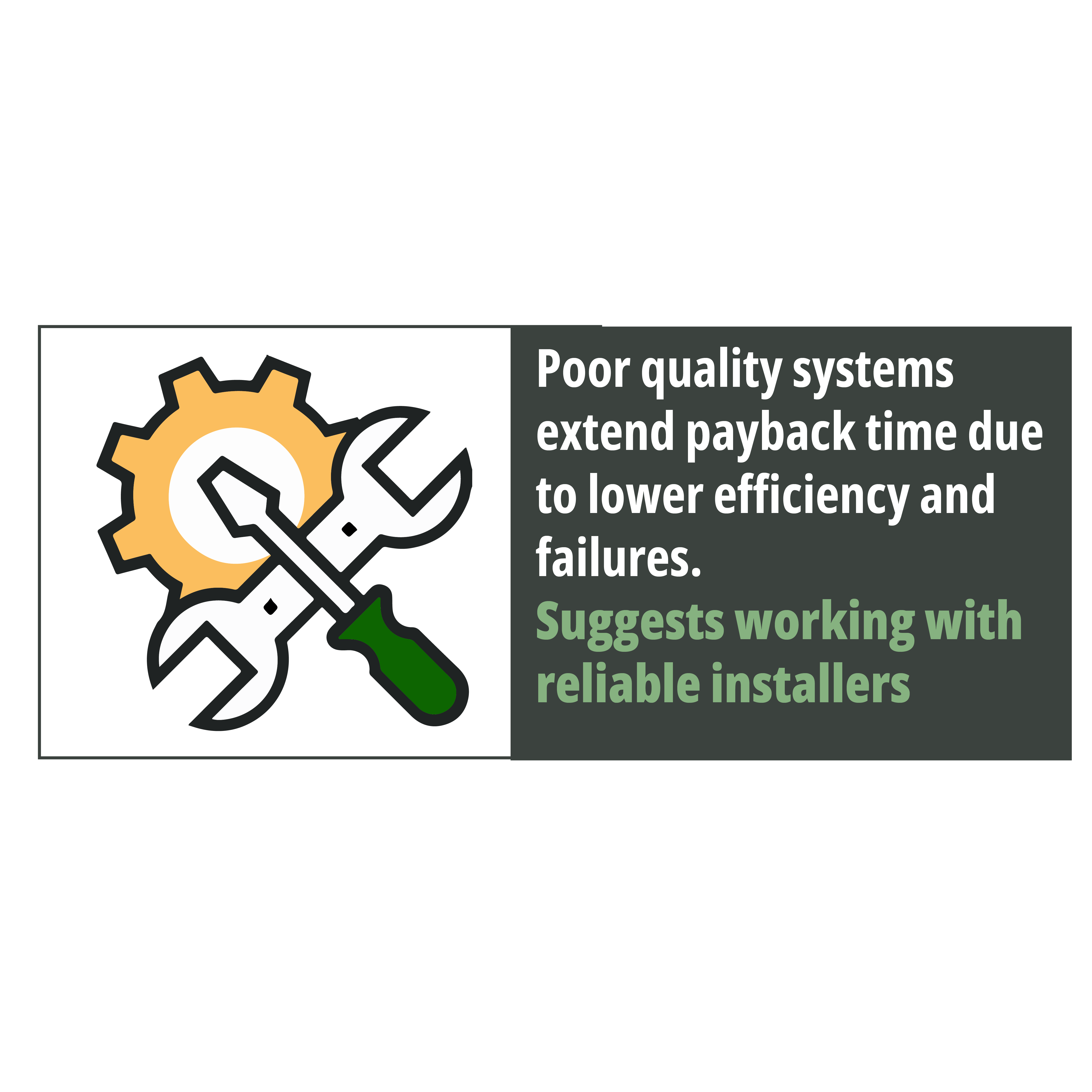
- Energy Usage and Consumption
The amount of electricity your household consumes directly impacts how quickly you can recoup your costs. If your system is undersized for energy needs, you may not generate enough electricity to offset your bills significantly. Properly sizing your system based on accurate energy usage data is essential for setting realistic payback expectations.
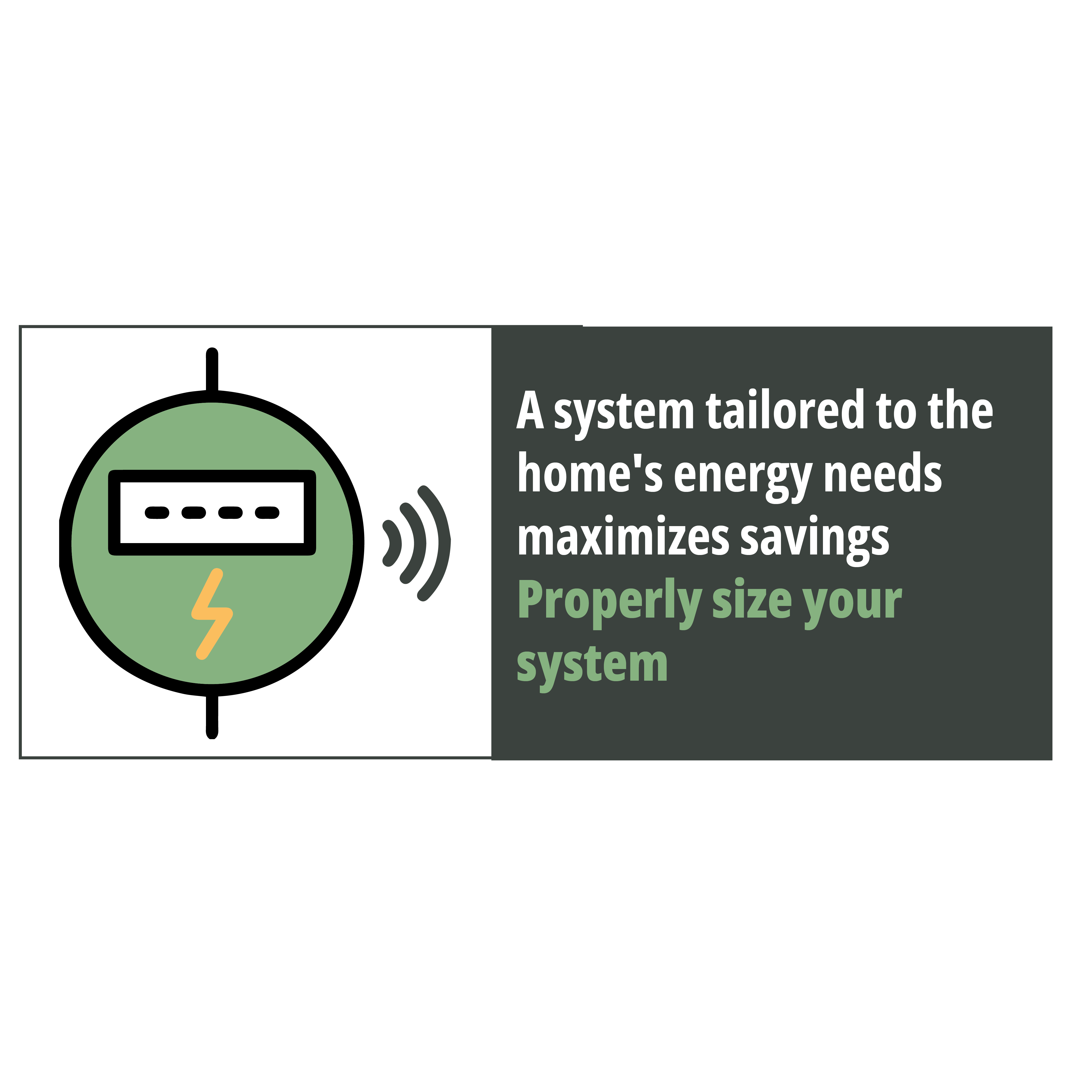
- Electricity Rates
The higher the cost of electricity from your local utility, the more you can save with solar. In states like California, where electricity rates are high, homeowners see a solar payback period of 5 to 7 years. In contrast, states with lower electricity rates, like Oregon, may have more extended payback periods—closer to 10 or 12 years. Remember that if utility rates increase over time, as they often do, your solar savings may grow faster, shortening your payback period¹.
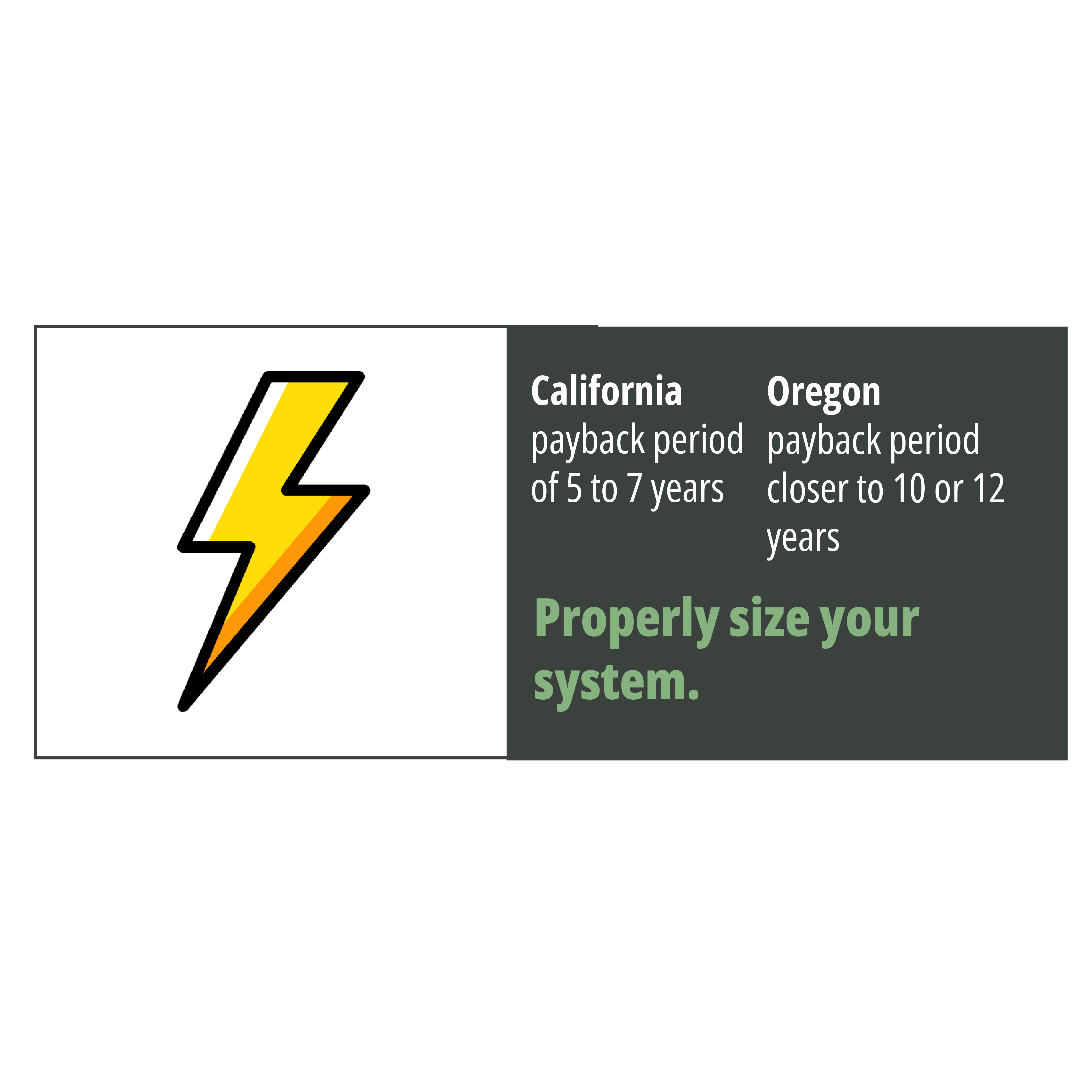
- Local Incentives and Rebates: Your payback period also depends on local incentives. For instance, Oregon has a range of state-specific solar incentives, but their availability and effectiveness can fluctuate based on government policy changes. Additionally, certain utilities offer rebates or performance-based incentives that can drastically reduce your upfront costs and shorten your payback period.
Stay updated on federal incentives like the 30% federal solar tax credit (ITC), which can significantly reduce costs and improve your return on investment¹¹.
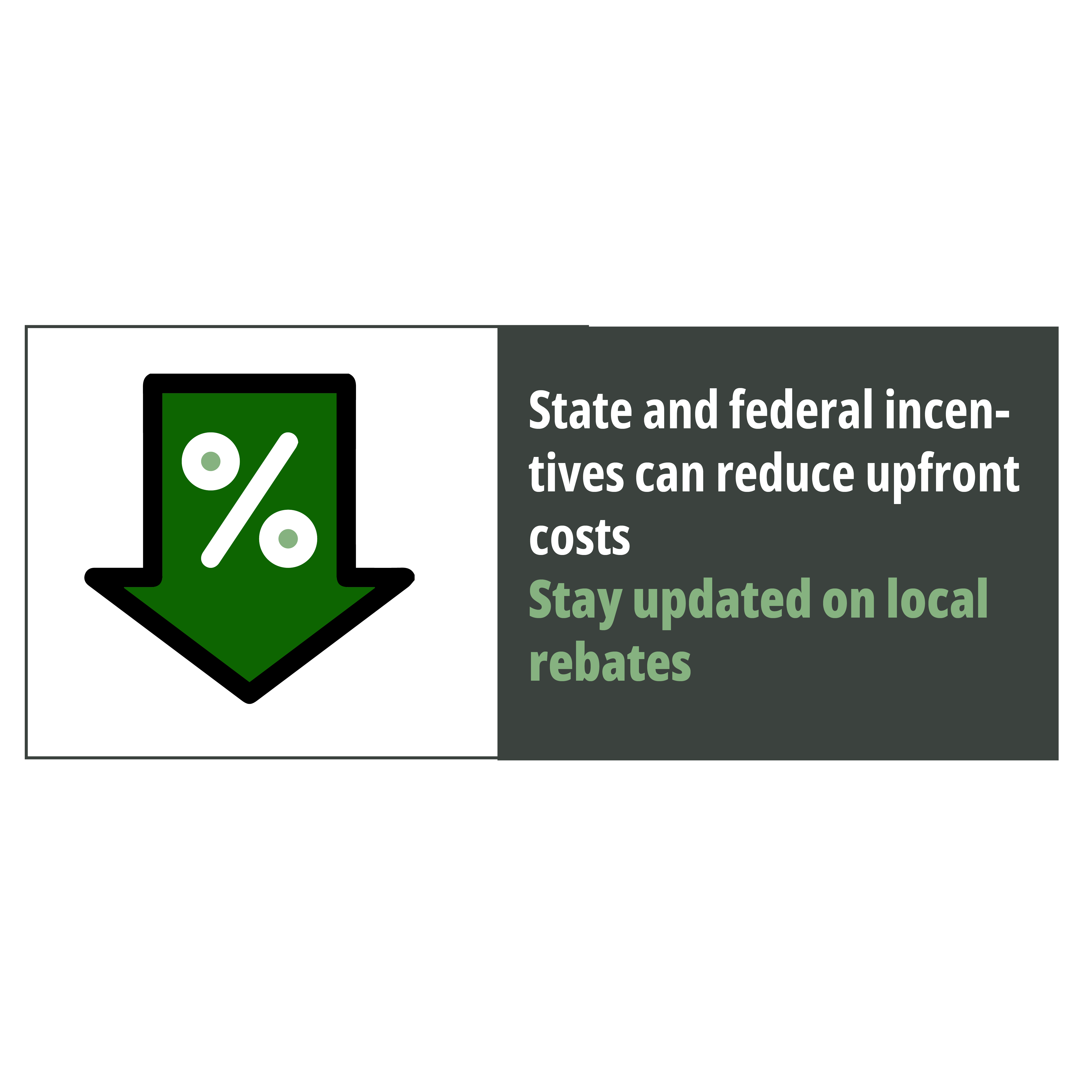
- Maintenance and System Performance: Regular maintenance is critical to ensuring your solar system operates at peak efficiency. Dirty panels or shading from trees can reduce energy output by 15-25%, delaying your payback period. Proactively maintaining your system by cleaning panels and trimming foliage will ensure maximum energy production and savings over time ¹.
Homeowners should be cautious of over-promised payback periods when solar systems are being sold. While quality equipment, accurate system sizing, and taking full advantage of incentives can help shorten the timeline, external factors such as electricity rates and maintenance play a significant role. For most, a realistic solar payback period ranges from 6 to 12 years, depending on location, system, and energy use.

The key takeaway? Set realistic expectations and invest in high-quality systems to maximize your savings. Always consult reputable installers who prioritize transparency and long-term service.
What factors can cause a decrease in expected solar energy output, and how can homeowners address these issues?
Several factors can decrease solar energy output, from shading to high temperatures. EnergySage points out that nearby trees, buildings, or even accumulated debris can reduce a panel’s efficiency by casting shadows that block sunlight. Regular tree trimming and debris removal can help maintain optimal efficiency¹².
Additionally, high temperatures can reduce a panel’s performance. Solar panels are most efficient at around 25°C (77°F), and excessive heat can lower their output. Ensuring proper installation that allows airflow between the panels and the roof can mitigate overheating issues.
Lastly, panel degradation is inevitable. Most solar panels degrade at 0.25% to 0.75% per year. Choosing high-quality panels with solid warranties can help mitigate this degradation and ensure long-term performance. “Proper permitting and insurance are foundational to ensuring that your solar installation is legally compliant and financially protected against unforeseen events,” advises a solar expert¹.
What are homeowners' most common solar maintenance issues with rooftop solar installations?
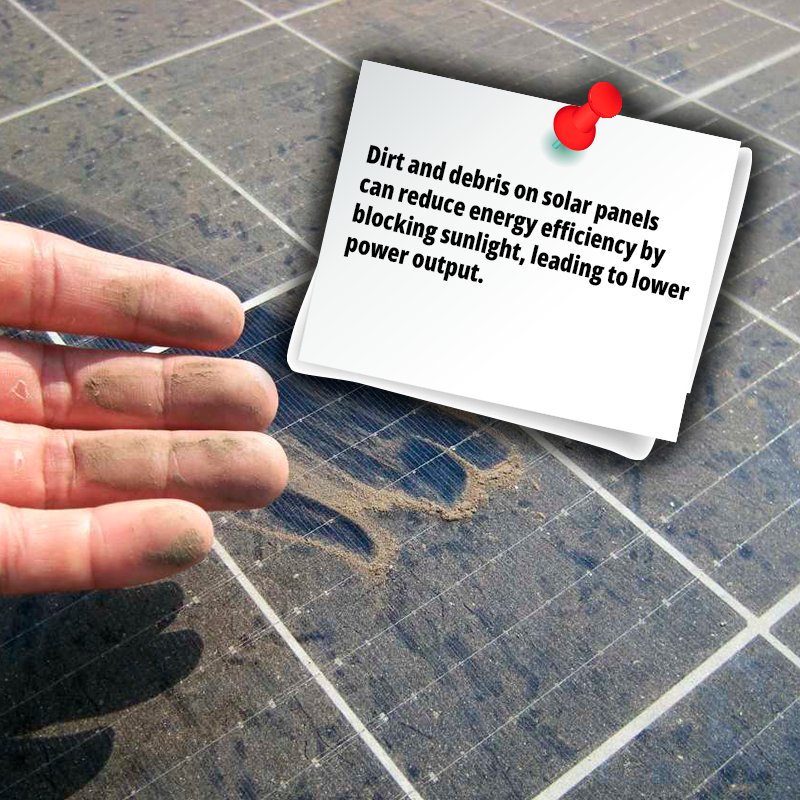
Proper solar panel maintenance is crucial to maintaining efficiency and protecting your investment. The most common issues include dirt accumulation, damaged wiring, and inverter failures. Dirt accumulation can lead to a 15-25% decrease in energy output, depending on the location and how often the panels are cleaned. This is especially important in areas prone to dust, pollen, or bird droppings. Homeowners should be aware that neglecting regular cleaning could significantly reduce energy production, directly impacting savings on utility bills¹.

Another common issue is inverter failure. Inverters typically need replacement every 10 to 15 years, with the replacement cost ranging from $1,000 to $2,500, depending on system size and the type of inverter used. Given the crucial role inverters play in converting the energy generated by solar panels into usable electricity, their failure can cause significant downtime. “Inverters are the heart of your solar system,” explains a technician, emphasizing their importance for system health.
By performing regular maintenance, including cleaning panels and monitoring inverters for signs of failure, homeowners can prevent substantial losses in energy efficiency and avoid unexpected repair costs.
How can homeowners protect their solar panel wiring and systems from rooftop pests like squirrels or pigeons?
Pest interference and, yes, ‘bird shit’ is a common problem for solar panel systems. Birds, squirrels, and other critters can nest under panels or chew on wiring, leading to potential damage. The U.S. Department of Energy (DOE) recommends several strategies to protect your system from these threats, such as installing protective mesh or critter guards around the panels⁴.
These barriers prevent pests from accessing and damaging vital wiring. Regular inspections are also crucial. Homeowners should check for signs of nesting or chewing and ensure that surrounding trees and vegetation are trimmed to prevent animals from gaining easy access to the rooftop.
“Ensuring they are well-maintained and protected against environmental factors is key to uninterrupted energy production,” advises a solar expert⁵.
What should you do if your solar panel’s monitoring system stops working temporarily?
Solar panel monitoring systems are essential for tracking your system’s performance. However, they can sometimes fail, leaving homeowners unsure about how much energy their panels produce. If this happens, a few troubleshooting steps can help.
According to discussions on Solar Panel Talk, one standard solution is to reboot the inverter or reset the monitoring system. This simple step often resolves temporary communication issues between the monitoring app and the panels⁶. Checking the internet connection is another essential step, as poor connectivity can disrupt data transmission from the monitoring system.
If these steps don’t solve the problem, contacting tech support or your solar installer can provide additional help. In some cases, they can diagnose and fix issues remotely. “When an installer goes out of business, homeowners are often left scrambling for support,” explains a solar expert ⁷. This emphasizes the importance of choosing a reputable installer with reliable customer support.
What potential risks are associated with older solar systems that don’t use microinverters or optimizers?
Older solar systems, especially those relying on traditional string inverters, can face several challenges regarding efficiency and safety. Without microinverters or optimizers, these systems may be more vulnerable to shading issues and performance degradation.
According to Solar Power World, systems with string inverters suffer from a collective energy loss if just one panel is shaded. In contrast, microinverters allow each panel to operate independently, minimizing the impact of shading⁸. Additionally, traditional systems with long DC wiring runs pose a more significant electrical hazard, especially in emergencies like fires, where high-voltage lines can remain live.
For these reasons, upgrading to a modern system with microinverters improves performance and enhances the installation’s overall safety. “A well-designed solar installation not only provides energy savings but can also enhance the overall look of your home,” notes a solar expert⁹.
At Advanced Energy Systems, we are dedicated to helping Oregon homeowners achieve energy independence and avoid common pitfalls by providing expert guidance, quality installations, and ongoing support. We aim to ensure that your investment in solar energy delivers the maximum return with minimal hassle, offering you peace of mind and reliable savings for years.
References:
- Solar Reviews. (2023). How to calculate your solar payback period. https://www.solarreviews.com/blog/how-to-calculate-your-solar-payback-period
- Solar Energy Industries Association. (2023). Residential guide to solar power. https://www.seia.org/wp-content/uploads/2015/06/Resi20Guide20to20Solar20Power20June202023_0.pdf
- The Energy Show. (2016, September 24). What could go wrong with your home solar system? https://podcasts.apple.com/us/podcast/the-energy-show/id986907878?i=1000375745315
- U.S. Department of Energy. (2023). Walk me through it: A step-by-step guide for consumers going solar. https://www.energy.gov/eere/solar/articles/walk-me-through-it-step-step-guide-consumers-going-solar
- NPR. (2024, July 12). Rooftop solar panels: Energy bills and marketing. https://www.npr.org/2024/07/12/1197961036/rooftop-solar-panels-energy-bills-marketing
- Solar Panel Talk. (2022). Monitoring system troubleshooting guide. https://www.solarpaneltalk.com/forum/solar-panels-for-home
- The Energy Show. (2016, September 24). What could go wrong with your home solar system? https://podcasts.apple.com/us/podcast/the-energy-show/id986907878?i=1000375745315
- Solar Power World. (2014). Microinverters vs. string inverters: Which is safer? https://www.solarpowerworldonline.com/2014/04/microinverters-power-optimizers-affect-maintenance/
- The Energy Show. (2016, September 24). What could go wrong with your home solar system? https://podcasts.apple.com/us/podcast/the-energy-show/id986907878?i=1000375745315
- EnergySage. (2023). Solar panel replacement guide. https://www.energysage.com/solar/how-to-choose-the-best-solar-panel-for-you/
- Solar Energy Industries Association. (2023). Residential guide to solar power. https://www.seia.org/wp-content/uploads/2015/06/Resi20Guide20to20Solar20Power20June202023_0.pdf
- EnergySage. (2023). How shading impacts solar panel efficiency. https://www.energysage.com/solar/underperforming-solar-panels/



